Pump Handbook by Igor J. Karassik, Joseph P. Messina, Paul Cooper, Charles C. Heald - 3rd edition
Подождите немного. Документ загружается.

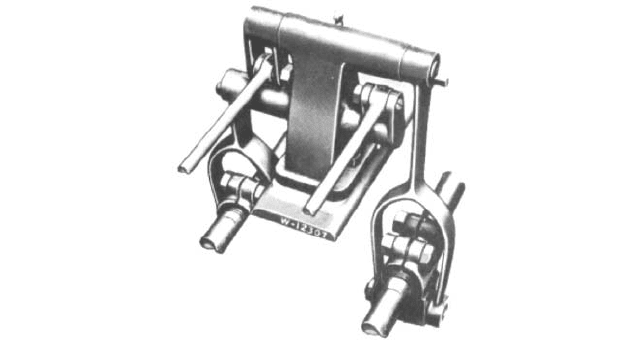
3.42 CHAPTER THREE
1. One or more steam cylinders with suitable steam inlet and exhaust connections
2. Steam piston with rings
3. Steam piston rods directly connected to liquid piston rods
4. Steam valves that direct steam into and exhaust steam from the steam cylinder
5. A steam valve actuating mechanism that moves the steam valve in proper sequence
to produce reciprocating motion
The operation of a steam pump is quite simple.The motion of the piston is obtained by
admitting steam of sufficient pressure to one side of the steam piston while simultane-
ously exhausting steam from the other side of the piston. There is very little expansion of
the steam because it is admitted at a constant rate throughout the stroke. The moving
parts, that is, the steam piston, the liquid piston, and the piston rod or rods, are cushioned
and brought to rest by exhaust steam trapped in the end of the steam cylinder at the end
of each stroke. After a brief pause at the end of the stroke, steam is admitted to the oppo-
site side of the piston and the pump strokes in the opposite direction.
Steam Valves Because the steam valve and its actuating mechanism control the recip-
rocating motion, any detailed description of the construction of the direct-acting steam pump
should rightfully begin with a discussion of steam valve types, operation, and construction.
Duplex Steam Valves The steam valves in a duplex steam pump are less complicated
than those in a simplex pump and will be described first. As previously stated, the duplex
steam pump can be considered as two simplex pumps arranged side by side and combined
to operate as a single unit. The piston rod of one pump, in making its stroke, actuates the
steam valve and thereby controls the admission or exhaust of steam in the second pump.
A valve gear cross stand assembly is shown in Figure 8. The wishbone-shaped piston rod
lever of one side is connected by a shaft to the valve rod crank of the opposite side. The
steam valve is connected to the valve rod crank by the steam valve rod and steam valve
link. Through this assembly, the piston rod of one side moves the steam valve of the oppo-
site side in the same direction. When the first pump has completed its stroke, it must
pause until its own steam valve is actuated by the movement of the second pump before
it can make its return stroke. Because one or the other steam cylinder port is always open,
there is no “dead center” condition; hence, the pump is always ready to start when steam
FIGURE 8 Steam valve actuating mechanism or a duplex pump (Flowserve Corporation)
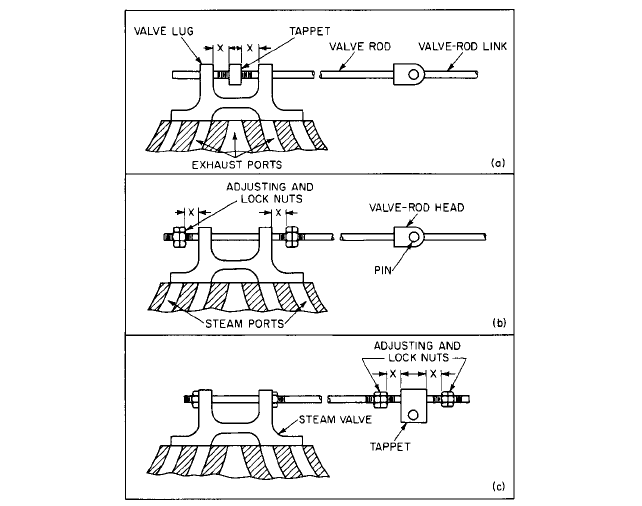
3.3 STEAM PUMPS 3.43
FIGURE 9A through C Duplex pump steam valve lost-motion arrangements
1
1 bar 10
5
Pa.
is admitted to the steam chest. The movements of both pistons are synchronized to pro-
duce a well-regulated flow of liquid free of excessive pulsations and interruptions.
Flat Slide Steam Valves Steam enters the pump from the steam pipe into the steam
chest on top of the steam cylinder. Exhaust steam leaves the pump through the center
port of five ports, as shown in Figure 9. Most duplex pumps use a flat slide valve that is
held against its seat by steam pressure acting upon its entire top area; this is called an
unbalanced valve. The flat or D valve, as it is often called, is satisfactory for steam pres-
sures up to approximately 250 lb/in
2
(17 bar
1
) and has a reasonable service life, particu-
larly where steam end lubrication is permissible. On large pumps, the force required to
move an unbalanced valve is considerable, and so a balanced piston valve, which will be
discussed later, is used.
The slide valve shown in Figure 9 is positioned on dead center over the five valve ports.
A movement of the valve to the right uncovers the left-side steam port and the right-side
exhaust port, which is connected through the slide valve to the center exhaust port. The
main steam piston will be moved from left to right by the admitted steam. Movement of
the slide valve from dead center to the left would, of course, cause opposite movement of
the steam piston.
The steam valves of a duplex pump are mechanically operated, and their movements
are dependent upon the motion of the piston rod and the linkage of the valve gear. In order
to ensure that one piston will always be in motion when the other piston is reversing at the
end of its stroke, lost motion is introduced into the valve gear. Lost motion is a means by
which the piston can move during a portion of its stroke without moving the steam valve.
Several lost motion arrangements are shown in Figure 9.

3.44 CHAPTER THREE
If the steam valves are out of adjustment, the pump will have a tendency not to oper-
ate through its designed stroke. Increasing the lost motion lengthens the stroke; if this is
excessive, the piston will strike the cylinder head. Reducing the lost motion shortens the
stroke; if this is excessive, the pump will short-stroke, with a resulting loss in capacity.
The first step in adjusting the valves is to have both steam pistons in a central position
in the cylinder. To accomplish this, the piston is moved toward the steam end until the pis-
ton strikes the cylinder head. With the piston rod in this position, a mark is made on the
rod flush with the steam end stuffing box gland. Next, the piston rod is moved toward the
liquid end until the piston strikes, and then another mark is placed on the rod halfway
between the first mark and the steam end stuffing box gland. After this, the piston rod is
returned toward the steam end until the second mark is flush with the stuffing box gland.
The steam piston is now in central position. This procedure is repeated for the opposite pis-
ton rod assembly.
The next step is to see that both steam valves are in a central position with equal
amounts of lost motion on each side, indicated by distance X in Figure 9.
Most small steam pumps are fitted with a fixed amount of lost motion, as shown in Fig-
ure 9a. With the slide valve centered over the valve ports, a properly adjusted pump will
have the tappet exactly centered in the space between the valve lugs. The lost motion (X)
on each side of the tappet will be equal.
Larger pumps are fitted with adjustable lost motions, such as are shown in Figure 9b.
The amount of lost motion (X) can be changed by moving the locknuts. Manufacturers pro-
vide specific instructions for setting proper lost motion. However, one rule of thumb is to
allow half the width of the steam port on each side for lost motion. A method to provide
equality of lost motion is to move the valve each way until it strikes the nut and then note
if both port openings are the same.
In some cases, it is desirable to be able to adjust the steam valves while the pump is in
motion. With the arrangements previously mentioned, this cannot be done because the
steam chest head must be removed. In a pump equipped with a lost-motion mechanism
such as that shown in Figure 9c, all adjustments are external and can therefore be made
while the pump is in operation.
Balanced Piston Steam Valve Thebalanced piston steam valve (Figure 10) is used on
duplex steam pumps when the slide-type valve cannot be used because of size. The bal-
anced piston valve can also be used without lubrication at pressure above 250 lb/in
2
(17
bar) and temperatures above 500°F (260°C). At higher pressures, wire drawing or steam
cutting can occur as the piston slowly crosses the steam ports. To prevent wear and per-
manent damage to the steam chest and piston, piston rings are used on the steam valve
and a steam chest liner is pressed into the steam chest to protect it.
Cushion Valves Steam cushion valves are usually furnished on larger pumps to act as
an added control to prevent the steam piston from striking the cylinder heads when the
pump operates at high speeds.As previously shown, the steam end has five ports, the out-
side ports are for steam admission, and the inside ports are for steam exhaust. As the
steam piston approaches the end of the cylinder, it covers the exhaust port, trapping a vol-
FIGURE 10 Balanced piston steam valve: (12) piston valve, (181) steam chest, (23) valve rod stuffing box,
(24) valve rod stuffing box gland, (54) valve rod, complete, (57) valve rod head, (14) piston valve ring, (16) piston
valve lining, (47) lost-motion block tappet, (491) valve rod link, (563) valve rod collar (Flowserve Corporation)
3.3 STEAM PUMPS
ume of steam in the end of the cylinder. This steam acts as a cushion and prevents the
piston from striking the cylinder head. The cushion valve is simply a bypass valve between
the steam and exhaust ports; by opening or closing this valve, the amount of cushion
steam can be controlled.
If the pump is running at low speed or working under heavy load, the cushion valve
should be opened as much as possible without allowing the piston to strike the cylinder
head. If the pump is running at high speed or working under light load, the cushion valve
should be closed. The amount of steam cushion and, consequently, the length of stroke can
be properly regulated for different operating conditions by the adjustment of this valve.
Simplex Steam Valves The simplex pump steam valve is steam-operated, not mechan-
ically operated as duplex steam valves are. The reason for this is that the piston rod
assembly must operate its own steam valve. Consequently the travel of the valve cannot
be controlled directly by means of the piston rod motion. Instead, the piston rod operates
a pilot valve by means of a linkage similar to that used with a duplex pump. This controls
the flow of steam to each end of the main valve, shuttling the steam back and forth. The
arrangement illustrated in Figure 11 is one of the designs available to produce this
motion.
With the pilot valve in the position shown in Figure 11, steam from the live steam
space flows through the pilot valve steam port into the steam space at the left-hand end
of the main valve (balanced piston type). Simultaneously, the D section of the pilot valve
connects the steam space at the right-hand end of the main valve with the exhaust port,
thereby releasing the trapped steam. The main valve has moved completely across to the
right end of the chest.The main valve in this position permits steam to flow from the chest
to the left steam cylinder port and, at the same time, connects the right steam cylinder
port with the exhaust port.
The steam piston now moves to the right, and after the lost motion is taken up in the
valve gear, the pilot valve moves to the left. In this position, the cycle previously described
now takes place at the opposite end of the steam chest. Because the main valve is steam-
operated, it can be in only two positions, either at the left-hand or at the right-hand end of
the chest. Hence, it is impossible to have it at dead center. In other words, steam can
always flow either to one side or to the other of the steam piston, regardless of the position
of the steam piston.
For the valve to operate smoothly and quietly, an arrangement must be provided to cre-
ate a cushioning effect on the valve travel. The steam piston, as it approaches the end of
its travel, cuts off the exhaust port and traps a certain amount of steam, which acts as a
cushion and stops the steam piston.
All valve adjustments are outside of the steam chest, and so it is possible to adjust the
valve while the pump is in operation. The effect of decreasing or increasing the lost motion
is the same as that described for duplex pumps.The lost-motion arrangement is the same
as that shown in Figure 9c.
Steam End Materials For most services, cast iron is an excellent material for the steam
cylinder and it is the major element of the steam end. It is readily cast in the complicated
shape required to provide the steam porting. It possesses good wearing qualities, largely
because of its free graphite content. This is required in the piston bores, which are con-
tinuously being rubbed by the piston rings. At high steam temperatures and pressures,
ductile iron or steel is used. In the latter case, however, cast iron steam cylinder liners are
frequently used because of their better wear resistance.
Counterbores are provided at each end of a steam cylinder so the leading piston ring
can override, for a part of its width, the end of the cylinder bore to prevent the wearing of
a shoulder on the bore.
The cylinder heads and steam pistons are also usually made of cast iron. The cylinder
head has a pocket cast in it to receive the piston rod nut at the end of the stroke. Most
steam pistons are made in one piece, usually with two piston ring slots machined into the
outside circumference.
The relatively wide piston rings are usually made from hammered iron. They are split
so they can be expanded to fit over the piston and snapped into the grooves in the piston.
3.45
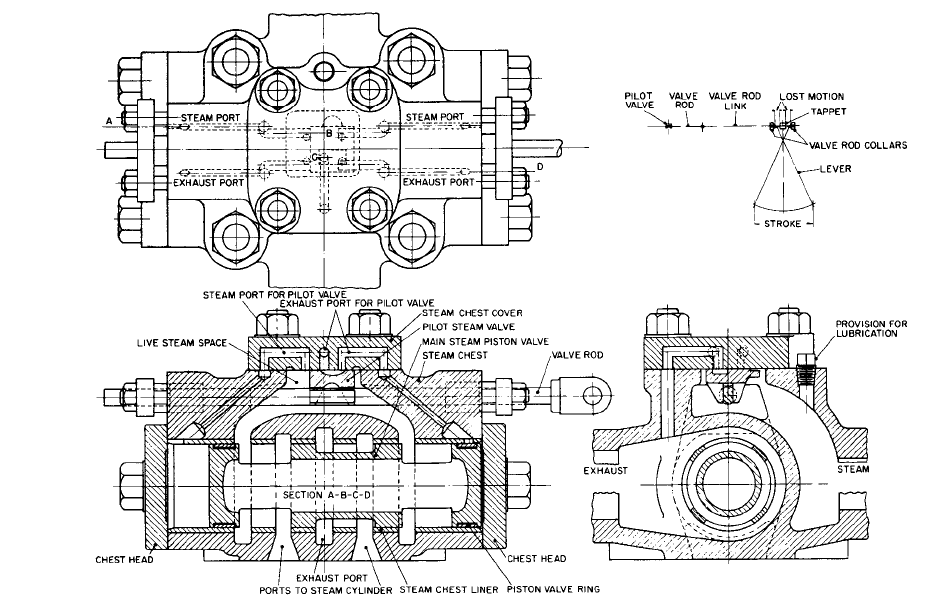
FIGURE 11 Simplex-type steam valve (Flowserve Corporation)
3.46

3.3 STEAM PUMPS 3.47
They must be compressed slightly to fit into the bores in the cylinder. This ensures a tight
seal with the cylinder bores even as the rings wear during operation. In services where
steam cylinder lubrication is not permissible, a combination two-piece ring of iron and
bronze is used to obtain longer life than is obtained with the hammered iron rings.
The piston and valve rods are generally made from steel, but stainless steel and Monel
are also commonly used. Packing for the rods is usually a braided graphited asbestos.
Drain cocks and valves are always provided to permit drainage of condensation, which
forms in the cylinder when a pump is stopped and cools down. On each start-up these
must be cracked open until all liquid is drained and only steam comes out; they are then
closed.
The steam end and liquid end are joined by a cradle. On most small pumps, the cradle
is cast integrally with the steam end. On large pumps, it is a separate casting or fabricated
weldment.
LIQUID END CONSTRUCTION __________________________________________
Steam pumps are equipped with many types of liquid ends, each being designed for a par-
ticular service condition. However, they can all be classified into two basic types, the pis-
ton, or inside-packed, type and the plunger, or outside-packed, type.
The piston pump (Figure 7) is generally used for low and moderate pressures. Because
the piston packing is located internally, the operator cannot see the leakage past it or
make adjustments that could make the difference between good operation and packing
failure. Generally, piston pumps can be used at higher pressures with noncorrosive liquids
having good lubricating properties, such as oil, than with corrosive liquids, such as water.
Plunger pumps, illustrated in Figure 12, are usually favored for high-pressure and
heavy-duty service. Plunger pumps have stuffing box packing and glands of the same type
as those on the piston rods of piston pumps. All packing leakage is external, where it is a
guide to adjustments that control the leakage and extend packing and plunger life. Dur-
ing operation, lubrication can be supplied to the external plunger packing to extend its life.
Lubrication cannot be supplied to the piston packing rings on a piston pump.
Piston-Type Liquid Ends The most generally used piston pump is the cap-and-valve
plate design, illustrated in Figure 7. This is usually built for low pressures and tempera-
tures, although some designs are used at up to 350 lb/in
2
(246 bar) of discharge pressure
and 350°F (177°C). The discharge valve units are mounted on a plate separate from the
cylinder and have a port leading to the discharge connection. A dome-shaped cap, subject
to discharge pressure, covers the discharge valve plate. The suction valve units are
mounted in the cylinder directly below their respective discharge valves.A passage in the
liquid cylinder leads from below the suction valves down between the cylinders of a duplex
pump to the suction connection.
FIGURE 12 Simplex-type plunger pump (Flowserve Corporation)
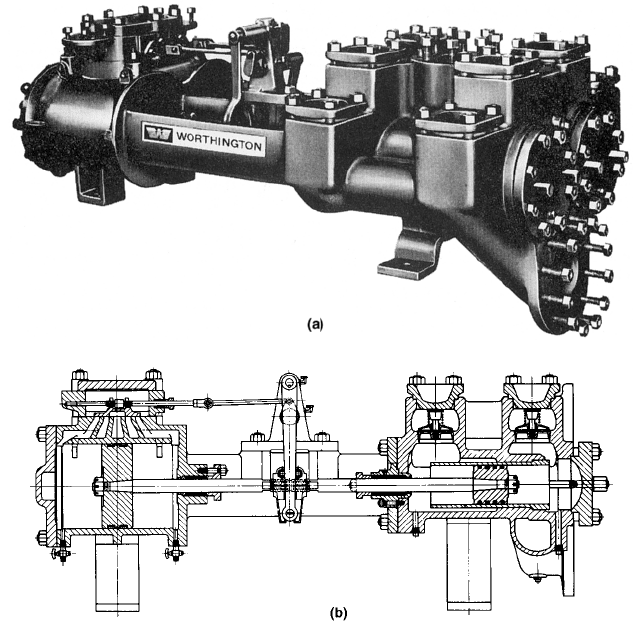
3.48 CHAPTER THREE
FIGURE 13A and B Side-pot piston pump (Flowserve Corporation)
Side-pot liquid ends are used where the operating pressures are beyond the limitations
of the cap-and-valve-plate pump. Figure 13 illustrates this design. Suction valves are
placed in individual pots on the side of the cylinders and discharge valves in the pots above
the cylinders. Each valve can be serviced individually by removing its cover. The small
area of the valve covers exposed to discharge pressure makes the sealing much simpler
than is the case in the cap-and-valve design. Side-pot liquid ends are widely used in refin-
ery and oil field applications.This design is commonly employed to the maximum pressure
practicable for a piston pump.
There are several specially designed piston-type liquid ends that have been developed
for specific applications. One of these is the close-clearance design illustrated in Figures 14
and 15. This pump can handle volatile liquids, such as propane or butane, or a liquid that
may contain entrained vapors.
The close-clearance cylinder is designed to minimize the dead space when the piston is
at each end of its stroke.The liquid valves are placed as close as possible to the pump cham-
ber to keep clearance to a minimum. The suction valves are positioned below the cylinder
at the highest points in the suction manifold to ensure that all the gases are passed into the
pump chamber. Although these pumps are of close-clearance design, they are not compres-
sors and can vapor-bind; that is, a large amount of gas trapped below the discharge valve
will compress and absorb the entire displacement of the pump. When this occurs, the dis-
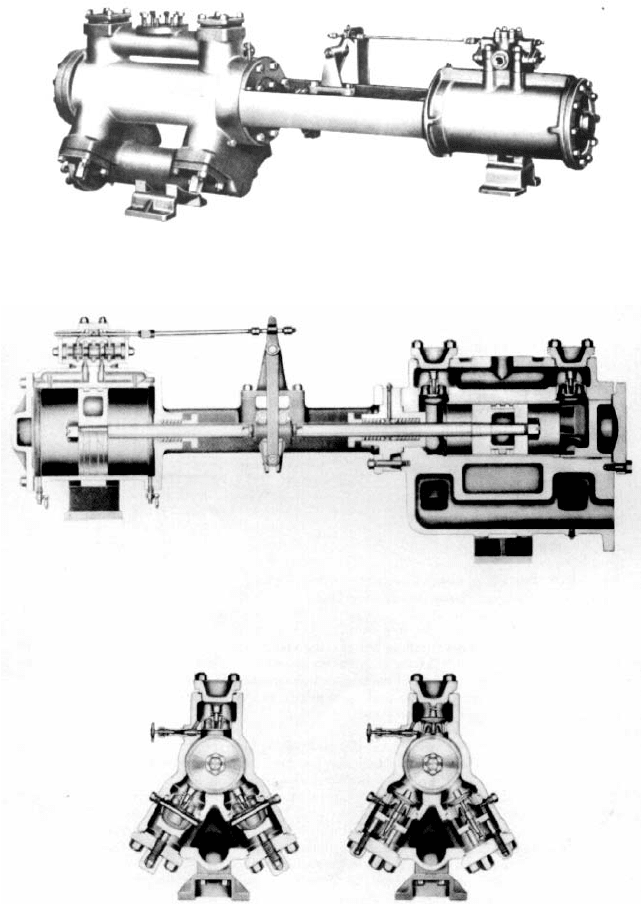
3.3 STEAM PUMPS 3.49
FIGURE 14 Close-clearance liquid end pump (Flowserve Corporation)
FIGURE 15 End views of close-clearance liquid end pump, showing disk valve assembly and wing valve assembly
(Flowserve Corporation)
charge valve will not open and this will cause a loss of flow. Hand-operated bypass or prim-
ing valves are provided to bypass the discharge valve and permit the trapped gases to
escape to the discharge manifold. When the pump is free of vapors, the valves are closed.
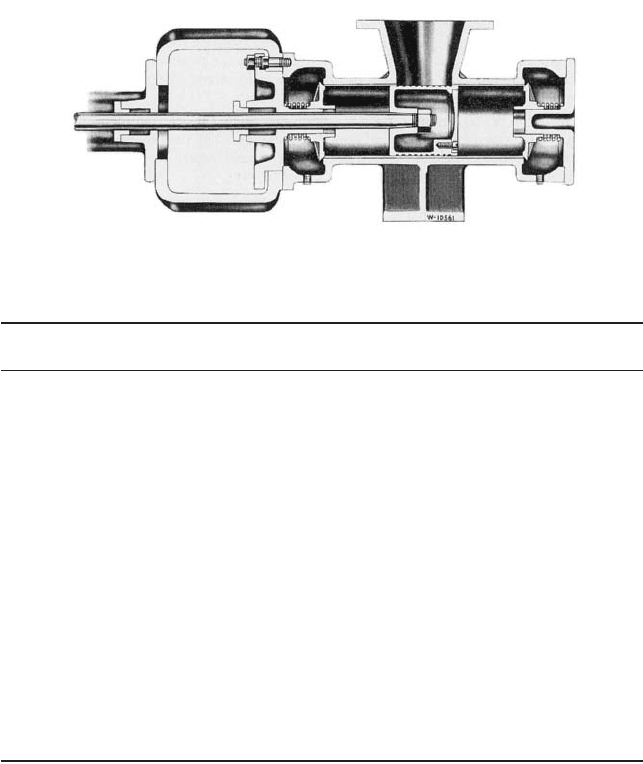
3.50 CHAPTER THREE
FIGURE 16 A pump for handling viscous liquid (Flowserve Corporation)
TABLE 1 Material and service specifications for pump liquid ends
Regular Bronze fitted Fully bronze All iron All bronze
Part fitted (RF) (BF) fitted (FBF) fitted (AIF) (AB)
Cylinders Cast iron Cast iron Cast iron Cast iron Bronze
Cylinder
liners Bronze Bronze Bronze Cast iron Bronze
Piston Cast iron Cast iron Bronze Cast iron Bronze
Piston
packing Fibrous Fibrous Fibrous Cast-iron, Fibrous
Stuffing Cast iron, Cast iron, Cast iron, 3-ring
box bronze bronze bronze
bushed bushed bushed Cast iron Bronze
Piston rod Steel Bronze Bronze Steel Bronze
Valve Bronze Bronze Bronze Steel Bronze
service
Services Cold water; Same as for Boiler feed; Oils and Mild acids that
for other RF, with intermittent other would attack
which cold reduced hot-water; hydrocarbons iron cylinders
most liquids maintenance; sodium not corrosive but not acid-
often not continuous chloride, to iron or resisting
used corrosive hot water brines steel; caustic bronze
to iron solutions
and
bronze
There are a number of other special piston pump designs for certain services in addi-
tion to the most common types just described. One of these special designs is the wet vac-
uum pump, which features tight-sealing rubber valves that permit the pump to handle
liquid and air or non-condensable vapors. Another special design is made of hard, wear-
resistant materials to pump cement grout on construction projects.Another design, shown
in Figure 16, has no suction valves and is made for handling viscous products such as sug-
arcane pulp, soap, white lead, printer’s ink, and tar. The liquid flows into the cylinder from
above through a suction port that is cut off as the piston moves back and forth.
Piston Pump Liquid End Materials and Construction The materials used for piston
pump liquid ends vary widely with the liquids handled. Most of the services to which these
pumps are applied use one of the common material combinations listed in Table 1.

3.3 STEAM PUMPS 3.51
The liquid cylinder, the largest liquid end component, is most frequently made from
cast iron or bronze. However, other materials are also used. Cast steel cylinders are used
in refineries and chemical plants for high-pressure and high-temperature applications.
Nickel cast steels are used for low-temperature services. Ni-Resist cast iron, chrome-alloy
steels, and stainless steels are occasionally used for certain corrosive and abrasive appli-
cations, but tend to make pump cost very high. The liquid cylinder heads and valve covers
are usually made from the same material as the liquid cylinder.
As was the case in the steam end, a liquid cylinder liner is used to prevent wear and
permanent damage to the liquid cylinder. Liners must be replaced periodically when worn
by the piston packing to the point that too much fluid leaks from one side of the piston to
the other. The liners may be either of a driven-in (or pressed-in) type or of a removable
type, which is bolted or clamped in position in the cylinder bore.
The pressed-in type (Figure 7) derives its entire support from the drive fit in the cylin-
der bore. As a rule, such a liner is relatively thin and is commonly made from a centrifu-
gal casting or a cold-drawn brass tube. After a driven liner is worn to the point where it
must be replaced, it is usually removed by chipping a narrow groove along its entire
length. This groove is cut as closely as possible through the liner without damaging the
wall of the cylinder bore. A flange on the liner fits into a recess at the beginning of the
cylinder bore. This flange is held in contact with a shoulder by jack bolts or a spacer
between the cylinder head and the end of the liner. Sometimes a packing ring is used
between the flange and shoulder for a positive seal. Removable liners are heavier than
pressed-in ones.
There are several designs of pistons and piston packings used for various applications.
The three most common are as follows:
1. The body-and-follower type of piston with soft fibrous packing or hard-formed
composition rings (Figure 17). The packing is installed in the packing space on the
piston with a clearance in both length and depth. This clearance permits fluid
pressure to act on one end and the inside of the packing to hold and seal it against
the other end of the packing space and the cylinder liner bore.
2. The solid piston or, as shown in Figure 18, a body and follower with rings of cast iron
or other materials. This type is commonly used in pumps handling oil or other hydro-
carbons.The metal rings are split with an angle or step-cut joint.Their natural tension
keeps them in contact with the cylinder liner, assisted by fluid pressure under the ring.
3. The cup piston (Figure 19), which consists of a body-and-follower type of piston with
molded cups of materials such as rubber reinforced with fabric. Fluid pressure on the
inside of the cup presses the lip out against the cylinder bore, forming a tight seal.
The piston rod stuffing boxes are usually made separate from, but of the same mater-
ial as, the liquid cylinder. When handling liquids with good lubrication properties, the
stuffing boxes are usually packed full with a soft, square, braided packing that is compat-
ible with the liquid. When the liquid has poor lubricating properties, a lantern ring is
FIGURE 17 Body-and-follower piston
FIGURE 18 Body-and-follower piston with snap
rings
